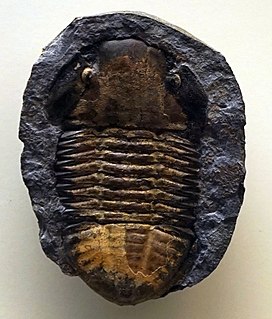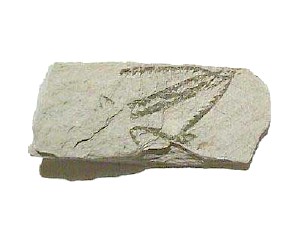 W
WAmpyx is an Ordovician-Silurian genus of Asaphid trilobites of the family Raphiophoridae. Species of Ampyx are characterized by three extended spines on the head-shield, one spine derived from each free cheek, and one spine emanating from the glabellum. Species include Ampyx linleyensis.
 W
WAngelina Salter, 1859, is a genus of ptychopariid olenid trilobite that lived during the Lower Ordovician. Fossils are known from Wales and South America. It differs from most other Triarthrinae in being larger, with a relatively narrow glabella, the occipital ring poorly defined, and lateral glabellar furrows relatively obscure. The eyes are placed midlength of the cephalon. The facial sutures converge on the front border at the midline. It also has long genal spines.
 W
WThe Anzaldo Formation is a Katian geologic formation of central Bolivia. The formation belongs to the Cochabamba Group, overlies the Capinota Formation and is overlain by the San Benito Formation.
 W
WThe Cancañiri Formation, also named as Cancañiri Tillite, is a Katian to Hirnantian geologic formation of central Bolivia. The pebbly, argillaceous sandstones, shales and siltstones of the up to 1,500 metres (4,900 ft) thick formation, were deposited in a glacial foreshore to deep water turbiditic environment. The formation is named after Cancañiri, a mining town close to Llallagua, where a local legend of a possessed woman is believed. The formation overlies the San Benito Formation in Cochabamba and the Amutara Formation in other parts. The Cancañiri Formation is overlain by the Uncía Formation.
 W
WDidymograptus is an extinct genus of graptolites with four rows of cups. They lived during the Middle Ordovician, to Late Ordovician.
 W
WHoekaspis is an extinct genus of trilobites from the family Asaphidae. It lived during the early part of the Arenig stage of the Ordovician, a faunal stage which lasted from approximately 466 to 461 million years ago.
 W
WThe Independencia Formation is a Dapingian geologic formation of western-central Bolivia. The dark to bluish gray schists and phyllites metamorphosed shales were deposited in an open marine environment.
 W
WThe Iscayachi Formation, in older literature also referred to as Guanacuno Formation, is an extensive Tremadocian geologic formation of western and southern Bolivia. The shales and sandstones were deposited in a shallow marine to pro-delta environment. The formation reaches a thickness of 1,000 metres (3,300 ft).
 W
WLa Ciénega Formation is a Sandbian to Katian geologic formation of south-central Bolivia. The formation comprises silty, clayey, micaceous, fine-grained sandstones with thin intercalations of grey-green to light grey shales.
 W
WMegistaspis is a genus of trilobites in the order Asaphida and family Asaphidae.
 W
WMesón Group is a Cambrian to Early Ordovician sedimentary formation located in the Argentine Northwest and nearby parts of Bolivia. The group members rest unconformably on top of the Ediacaran–Cambrian Puncoviscana Formation. According to G.F. Aceñolaza, the Mesón Basin – the sedimentary basin in which the Méson Group was deposited – was located between the Arequipa and Río de la Plata Cratons.
 W
WThe Obispo Formation is a Dapingian geologic formation of southern Bolivia. The shales and siltstones were deposited in an open marine environment.
 W
WThe Pircancha Formation is a Floian to Dapingian geologic formation of southern Bolivia. The green mudstones, shales and sandstones were deposited in a shallow to open marine environment. The fossil Pircanchaspis rinconensis is named after the formation.
 W
WSacabambaspis is an extinct genus of jawless fish that lived in the Ordovician period. Sacabambaspis lived in shallow waters on the continental margins of Gondwana. It is the best known arandaspid with many specimens. It is related to Arandaspis.
 W
WThe San Benito Formation is a Katian geologic formation of central Bolivia. The formation belongs to the Cochabamba Group, overlies the Anzaldo Formation and is overlain by the Cancañiri Formation. The 500 metres (1,600 ft) thick formation comprises a succession of shallow water quartzitic sandstones with minor interbeds of dark grey micaceous siltstones. Shelly fossils have been found at few horizons and consist mainly of linguliformean brachiopods, bivalves, and a few homalonotid trilobite remains. Poorly preserved graptolites occur occasionally in the shaly beds.
 W
WThe San Lorenzo Formation is a Dapingian geologic formation of southern Bolivia. The dark gray, greenish, and black shale with thin intercalations of white-yellow quartzites were deposited in an open marine submarine fan environment.
 W
WThe Santiago Formation is a Sandbian to Katian geologic formation of central Bolivia. The formation comprises gray quartzitic siltstones.
 W
WThe Sella Formation is a Dapingian to Darriwilian geologic formation of southern Bolivia. The grey to green bioturbated siltstones interbedded with thin sandstone layers bear lenticular shell beds. Other parts of the formation contain yellow-green limy shales and grey sandy limestones. Coquinas often fill gutter casts and included brachiopods, trilobites, bivalves and nautiloids. The sediments were deposited in an open marine environment. The species Coxiconchia sellaensis was named after the formation.
 W
WThe Tarija Concha Formation is a Tremadocian geologic formation of southern Bolivia. The shales and siltstones were deposited in a shallow marine environment.
 W
WTetragraptus is an extinct genus of graptolites from the Ordovician period.
 W
WThe Tucumilla Formation is a Tremadocian geologic formation of southern Bolivia. The sandstones, shales and siltstones crop out in the José María Avilés and Eustaquio Méndez Provinces.